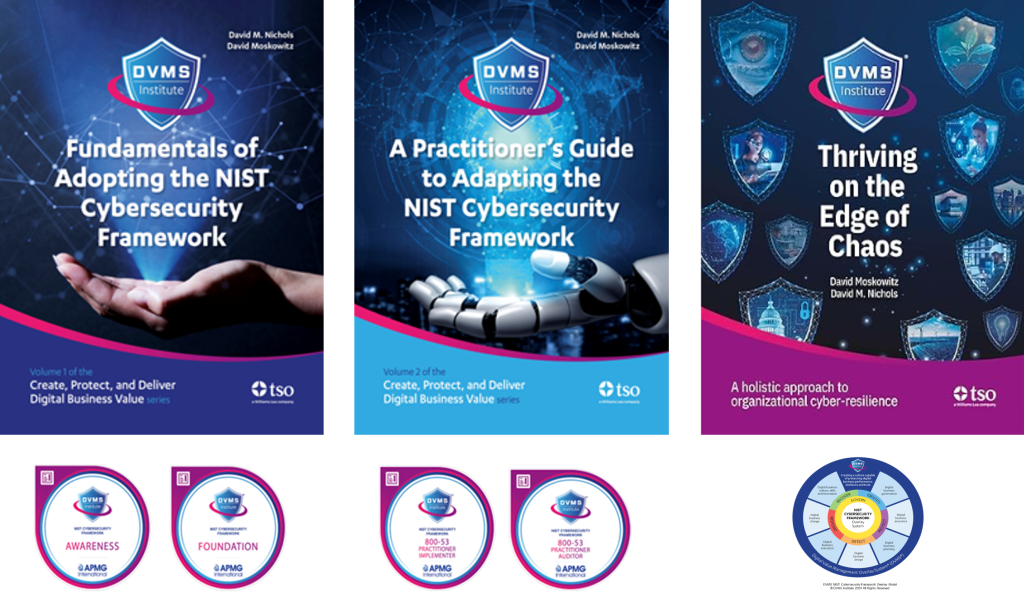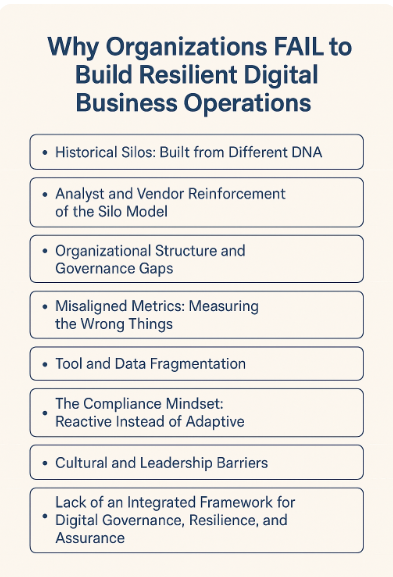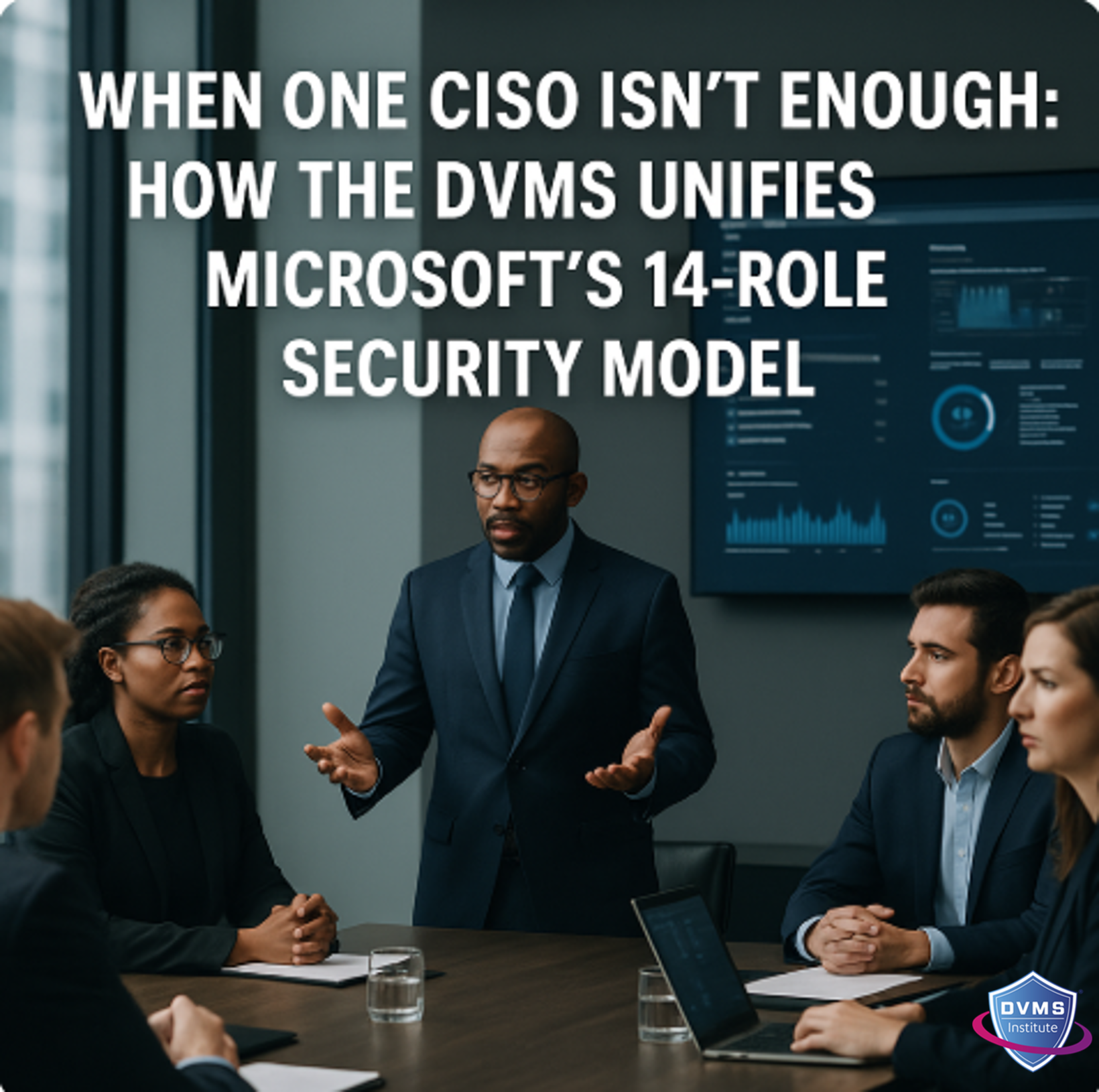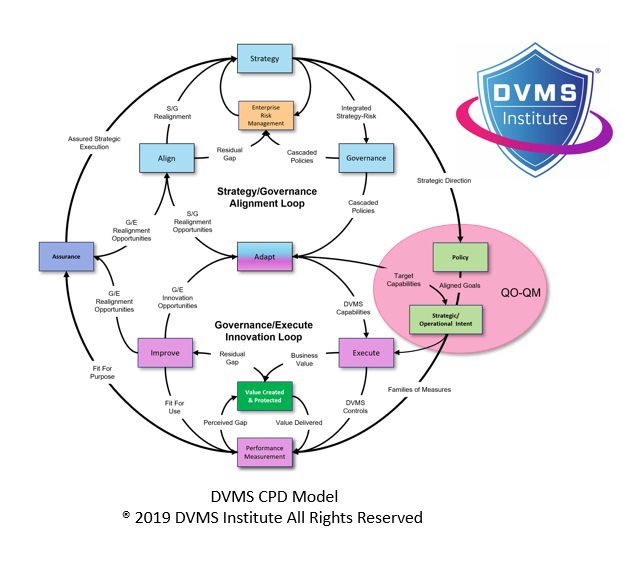Eight Reasons Why Organizations FAIL to Build Resilient Digital Business Operations
Rick Lemieux – Co-Founder and Chief Product Officer of the DVMS Institute
In a world where digital systems are the business, it’s astonishing how many organizations still fail to protect the very operations that sustain them. The problem isn’t a lack of technology, frameworks, or investment—it’s a failure of integration and intent.
Most enterprises still approach protection through isolated programs—cybersecurity, IT service management, and compliance—each operating within its own silo, language, and set of priorities. The result is a false sense of security: well-documented controls, efficient service desks, and expensive security tools that don’t add up to resilience.
Organizations don’t fail because they lack defenses; they fail because they lack governance, resilience, and assurance—the integrated disciplines that turn protection into sustained digital performance. Most organizations intend to integrate ITSM, GRC, and cybersecurity, but few actually achieve this integration. The reasons are systemic, not merely technical.
Let’s unpack them.
Reason 1 – Historical Silos: Built from Different DNA
Each of these disciplines — IT Service Management (ITSM), Governance/Risk/Compliance (GRC), and Cybersecurity — evolved independently, with distinct origins, languages, and success metrics:
- ITSM grew out of ITIL and operations management, focused on efficiency and uptime.
- GRC emerged from compliance and audit disciplines, focused on control and accountability.
- Cybersecurity developed from information assurance and defense, focused on protection and threat reduction.
Because they were built to solve different problems, they developed different vocabularies, processes, and toolchains. Each discipline built its own ecosystem — frameworks, certifications, vendors, and analyst quadrants — reinforcing separation rather than integration.
Result: Organizations end up with three different “governance systems” — one for compliance, one for IT service delivery, and one for security — each optimized in isolation.
Reason 2 – Analyst and Vendor Reinforcement of the Silo Model
Industry analysts and technology vendors have unintentionally contributed to the institutionalization of fragmentation.
- Analysts publish separate quadrants, maturity models, and reports for each discipline.
- Vendors design platforms optimized for one domain — GRC tools for auditors, ITSM tools for service desks, and cybersecurity tools for defenders.
These market divisions drive budget allocations, organizational charts, and reporting structures. When leadership identifies three separate market categories, they establish three distinct teams — each with its own KPIs and priorities.
Result: Integration becomes “someone else’s job,” usually deferred until after an incident or audit failure exposes the gaps.
Reason 3 – Organizational Structure and Governance Gaps
Most enterprises organize around functions, not systems.
- ITSM reports to operations.
- GRC reports to audit or risk.
- Cybersecurity reports to CISO or IT security.
This structure makes sense administratively, but kills cross-domain accountability. Each function optimizes for its silo rather than for enterprise assurance. There’s often no executive mandate — or framework — to unify them under a single governance and assurance model.
Without an overarching digital governance system, integration is left to informal collaboration, which tends to dissolve under the pressure of real-world disruptions.
Reason 4 – Misaligned Metrics: Measuring the Wrong Things
Each program measures success differently:
| Domain | Typical Focus | Limitation |
| ITSM | Ticket volume, SLA performance | Measures efficiency, not resilience |
| GRC | Control completion, audit findings | Measures compliance, not capability |
| Cybersecurity | Threat detection rates, incident counts | Measures defense, not assurance |
These metrics don’t align with enterprise outcomes, such as resilience, adaptability, or trust. As long as success is defined by functional metrics instead of shared assurance outcomes, integration will remain out of reach.
Reason 5 – Tool and Data Fragmentation
Every program runs on its own platform — ServiceNow for ITSM, Archer or MetricStream for GRC, and a constellation of security tools for cybersecurity.
Each system collects valuable data, but without shared taxonomies and data models, valuable insights remain locked within their respective domains. This makes it challenging to correlate operational performance with risk exposure or to link cybersecurity posture to business impact.
Result: No unified view of assurance — just overlapping dashboards that tell different stories.
Reason 6 – The Compliance Mindset: Reactive Instead of Adaptive
GRC programs are often trapped in a compliance mindset, focusing on passing audits rather than enhancing assurance. When compliance drives the agenda, integration becomes secondary.
Resilience requires continuous assurance, but compliance programs measure point-in-time conformance. This mismatch discourages proactive alignment with ITSM and cybersecurity, which operate continuously.
Reason 7 – Cultural and Leadership Barriers
Even when technology and frameworks align, culture remains the most rigid barrier.
- Risk teams speak the language of auditors.
- ITSM teams think in workflows and SLAs.
- Security teams think in terms of adversaries and controls.
Without shared governance language and culture, integration feels like negotiation instead of collaboration. Leadership must intentionally redefine governance culture — from a control-based to a value-based approach — before technical or process integration can succeed.
Reason 8 – Lack of an Integrated Framework for Digital Governance, Resilience, and Assurance
Finally, most organizations simply don’t have a unifying model.
GRC frameworks, such as ISO, COBIT, and COSO, were never designed to integrate dynamic IT operations or cybersecurity.
Emerging models such as the NIST Cybersecurity Framework (CSF) 2.0 and the Digital Value Management System® (DVMS) begin to fill this gap — connecting governance, resilience, and assurance into a continuous, adaptive system.
However, analysts and consultants still primarily promote traditional GRC tooling rather than adaptive governance systems, which hinders the adoption of integrated approaches.
The Path Forward: Integrated, Adaptive, and Culture-Driven Governance, Resilience, and Assurance
Organizations can no longer afford to treat resilience as a byproduct of risk or compliance—it must become the central pillar of how digital business is governed and assured.
The failures outlined throughout this paper are not technological in nature; they are structural, cultural, and conceptual. True digital resilience emerges when governance drives purpose, resilience ensures adaptability, and assurance validates trust continuously across all domains.
The path forward is clear: it’s time to retire fragmented GRC models and replace them with an integrated system of Governance, Resilience, and Assurance (GRA) that aligns leadership, culture, and capability. Only through this transformation can organizations protect, sustain, and grow their digital business operations with confidence in an era defined by constant disruption.
About the Author

Rick Lemieux
Co-Founder and Chief Product Officer of the DVMS Institute
Rick has 40+ years of passion and experience creating solutions to give organizations a competitive edge in their service markets. In 2015, Rick was identified as one of the top five IT Entrepreneurs in the State of Rhode Island by the TECH 10 awards for developing innovative training and mentoring solutions for boards, senior executives, and operational stakeholders.
A Digital Value Management System® (DVMS) is an integrated and adaptive management system that unifies governance, resilience, and assurance—empowering organizations to sustain, protect, and innovate digital business operations amid continuous disruption.
For the CEO, a DVMS provides a clear line of sight between digital operations, business performance, and strategic outcomes—turning governance and resilience into enablers of growth and innovation rather than cost centers.
For the Board, a DVMS provides ongoing assurance that the organization’s digital assets, operations, and ecosystem are governed, protected, and resilient—supported by evidence-based reporting that directly links operational integrity to enterprise value and stakeholder trust.
For the CIO, a DVMS provides a structured way to align technology investments and operations with measurable business outcomes.
For the CRO, a DVMS embeds risk and resilience directly into operational processes, turning risk management into a driver of performance and adaptability.
For the CISO, a DVMS delivers a continuous assurance mechanism that demonstrates cyber resilience and digital trust across the enterprise and its supply chain.
By adopting a DVMS, organizations are positioned to:
- Maintain Operational Stability Amidst Constant Digital Disruption
- Deliver Digital Value and Trust Across A Digital Ecosystem
- Satisfy Critical Regulatory and Certification Requirements
- Leverage Cyber Resilience as a Competitive Advantage

DVMS Explainer Videos
- Architecture Video: David Moskowitz explains the DVMS System
- Case Study Video: Dr. Joseph Baugh Shares His DVMS Story.
- Overlay Model – What is an Overlay Model
- MVC ZX Model – Powers the CPD
- CPD Model – Powers DVMS Operations
- 3D Knowledge Model – Powers the DVMS Culture
- FastTrack Model – Enables A Phased DVMS Adoption
Digital Value Management System® is a registered trademark of the DVMS Institute LLC.
® DVMS Institute 2025 All Rights Reserved




